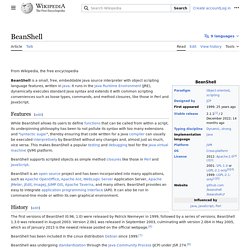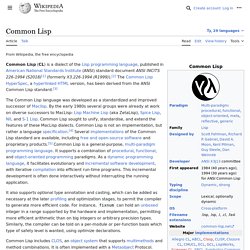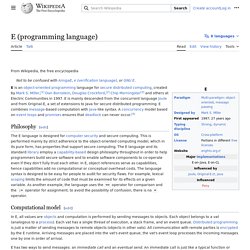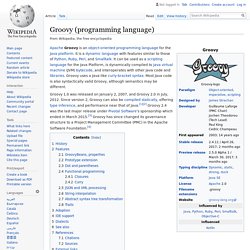

PHP (Dynamic Programming Languages) Dynamic programming language. This article is about a class of programming languages.

For the method for reducing the running time of algorithms, see Dynamic programming. Most dynamic languages are also dynamically typed, but not all are. Dynamic languages are frequently (but not always) referred to as "scripting languages", although the term "scripting language" in its narrowest sense refers to languages specific to a given run-time environment. Dynamic Programming. Python. Scripting & Shell Programming. ActionScript. ActionScript is an object-oriented programming language originally developed by Macromedia Inc.

(since merged into Adobe Systems). It is a derivation of HyperTalk, the scripting language for HyperCard.[2] It is now a dialect of ECMAScript (meaning it is a superset of the syntax and semantics of the language more widely known as JavaScript), though it originally arose as a sibling, both being influenced by HyperTalk. ActionScript is used primarily for the development of websites and software targeting the Adobe Flash Player platform, used on Web pages in the form of embedded SWF files. ActionScript is also used with Scaleform GFx for the development of 3D video game user interfaces and HUDs. Overview[edit] ActionScript was initially designed for controlling simple 2D vector animations made in Adobe Flash (formerly Macromedia Flash). Flash MX 2004 introduced ActionScript 2.0, a scripting language more suited to the development of Flash applications. BeanShell. Features[edit] BeanShell supports scripted objects as simple method closures like those in Perl and JavaScript.

BeanShell is an open source project and has been incorporated into many applications, such as Apache OpenOffice,[3] Apache Ant, WebLogic Server Application Server, jWork.ORG DataMelt, Apache JMeter,[4] jEdit, ImageJ,[5] JUMP GIS, Apache Taverna[6] and many others. BeanShell provides an easy to integrate API. It can also be run in command-line mode or within its own graphical environment. History[edit] The first versions of BeanShell (0.96, 1.0) were released by Patrick Niemeyer in 1999, followed by a series of versions. BeanShell has been included in the Linux distribution Debian since 1999.[8] BeanShell was undergoing standardization through the Java Community Process (JCP) under JSR 274.[9] Following the JCP approval of the BeanShell JSR Review Ballot in June 2005, no visible activity was taking place around BeanShell.[10] The JSR 274 status is "Dormant".
Clojure. ColdFusion Markup Language. "CFML" redirects here.

For the radio station, see CFML-FM. ColdFusion Markup Language, more commonly known as CFML, is a scripting language for web development that runs on the JVM, the .NET framework, and Google App Engine. Multiple commercial and open source implementations of CFML engines are available, including Adobe ColdFusion, Lucee, New Atlanta BlueDragon (who makes both a Java-based and a .NET-based version), Railo, and Open BlueDragon as well as other CFML server engines. Synopsis[edit] CFML can be written using either tags or CFScript, which is an ECMA script style language. The pages in a CFML application include the server-side CFML tags and functions in addition to HTML tags, and modern CFML applications also tend to have CFCs that are accessed by the CFML pages for executing business logic.
Common Lisp. Common Lisp includes CLOS, an object system that supports multimethods and method combinations.

It is often implemented with a Metaobject Protocol. History[edit] Work on Common Lisp started in 1981 after an initiative by ARPA manager Bob Engelmore to develop a single community standard Lisp dialect.[6] Much of the initial language design was done via electronic mail.[7][8] Guy Lewis Steele, Jr. gave at the 1982 ACM Symposium on LISP and functional programming the first overview of Common Lisp.[9] The first language documentation was published 1984 as Common Lisp the Language, first edition. A second edition, published in 1990, incorporated many changes to the language, made during the ANSI Common Lisp standardization process. Dylan (programming language) A concise and thorough overview of the language may be found in the Dylan Reference Manual.

Dylan's main design goal is to be a dynamic language well-suited for developing commercial software. Dylan attempts to address potential performance issues by introducing "natural" limits to the full flexibility of Lisp systems, allowing the compiler to clearly understand compilable units (i.e., libraries). Although deriving much of its semantics from Scheme and other Lisps—some implementations were in fact initially built within existing Lisp systems—Dylan has an ALGOL-like syntax rather than a Lisp-like prefix syntax. Dylan was created in the early 1990s by a group led by Apple Computer. At one point in its development it was intended for use with Apple's Newton computer, but the Dylan implementation did not reach sufficient maturity in time, and Newton instead used a combination of C and the NewtonScript developed by Walter Smith.
E (programming language) Here is a recursive function for computing the factorial of a number, written in E.

Functions are defined using the def keyword. In the first line, :int is a guard that constrains the argument and result of the function. A guard is not quite the same thing as a type declaration; guards are optional and can specify constraints. Gambas. Gambas is the name of an object-oriented dialect of the BASIC programming language as well as the integrated development environment that accompanies it.

Designed to run on Linux and other Unix-like computer operating systems,[3] its name is a recursive acronym for Gambas Almost Means Basic. Gambas is also the word for prawns in the Spanish and Portuguese language, from which the project's logos are derived. History[edit] Gambas 1.0.15 running from KDE. Groovy (programming language) On July 2, 2012, Groovy 2.0 was released, which, among other new features, added static compiling and static type checking.

Groovy provides native support for various markup languages such as XML and HTML, accomplished via an inline Document Object Model (DOM) syntax. This feature enables the definition and manipulation of many types of heterogeneous data assets with a uniform and concise syntax and programming methodology. GNU Octave. GNU Octave is software featuring a high-level programming language, primarily intended for numerical computations.

It provides a command-line interface for solving linear and nonlinear problems numerically, and for performing other numerical experiments using a language that is mostly compatible with MATLAB. It may also be used as a batch-oriented language. Since it is part of the GNU Project, it is free software under the terms of the GNU General Public License. History[edit] JavaScript. JavaScript (/ˈdʒɑːvəˌskrɪpt/[5]) is a high-level, dynamic, untyped, and interpreted programming language. It has been standardized in the ECMAScript language specification. Alongside HTML and CSS, it is one of the three core technologies of World Wide Web content production; the majority of websites employ it and it is supported by all modern Web browsers without plug-ins.
Julia (programming language) According to the official website, the main features of the language are: In Julia, Dylan and Fortress, on the other hand, this extensibility is the default, and the system's built-in functions are all generic and extensible. In Dylan, multiple dispatch is as fundamental as it is in Julia: all user-defined functions and even basic built-in operations like + are generic. Dylan's type system, however, does not fully support parametric types, which are more typical of the ML lineage of languages.
Lua (programming language) Lua was created in 1993 by Roberto Ierusalimschy, Luiz Henrique de Figueiredo, and Waldemar Celes, members of the Computer Graphics Technology Group (Tecgraf) at the Pontifical Catholic University of Rio de Janeiro, in Brazil. Versions of Lua prior to version 5.0 were released under a license similar to the BSD license. From version 5.0 onwards, Lua has been licensed under the MIT License. Both are permissive free software licences and are almost identical. or like so: MATLAB. Although MATLAB is intended primarily for numerical computing, an optional toolbox uses the MuPAD symbolic engine, allowing access to symbolic computing abilities. An additional package, Simulink, adds graphical multi-domain simulation and model-based design for dynamic and embedded systems.
As of 2017, MATLAB has over 2 million users across industry and academia.[7] MATLAB users come from various backgrounds of engineering, science, and economics. History[edit] MATLAB was first adopted by researchers and practitioners in control engineering, Little's specialty, but quickly spread to many other domains. It is now also used in education, in particular the teaching of linear algebra, numerical analysis, and is popular amongst scientists involved in image processing.[8] Objective-C. Objective-C source code 'implementation' program files usually have .m filename extensions, while Objective-C 'header/interface' files have .h extensions, the same as C header files. Objective-C++ files are denoted with a .mm file extension. History[edit] Objective-C was created primarily by Brad Cox and Tom Love in the early 1980s at their company Stepstone.[3] Both had been introduced to Smalltalk while at ITT Corporation's Programming Technology Center in 1981.
The earliest work on Objective-C traces back to around that time.[4] Cox was intrigued by problems of true reusability in software design and programming. Prolog. Python (programming language) R (programming language) Ruby (programming language) Smalltalk. SuperCollider. Tcl. Tcl. VBScript. Windows PowerShell. Wolfram Language. Programming Languages. Programming. Computer Technology. Technology.